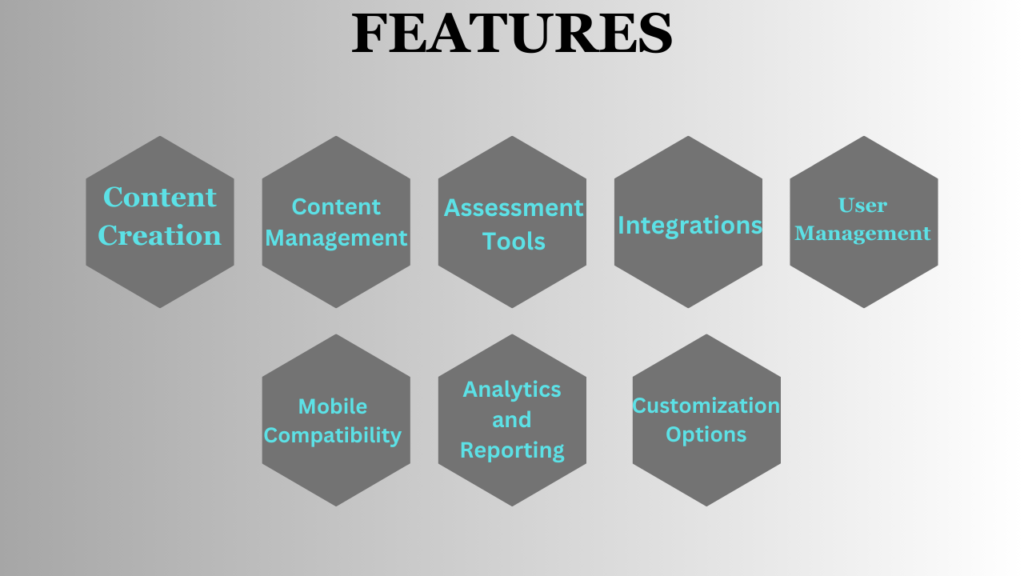Introduction
Embark on a journey to discover the best learning content management systems (LCMS) that will transform the way you deliver and manage educational materials. In this comprehensive guide, we explore the key features, user interfaces, content delivery methods, analytics, security measures, integration capabilities, and support options of the leading LCMS platforms. Whether you’re an educator, corporate trainer, or e-learning enthusiast, finding the right LCMS is crucial for delivering engaging and effective learning experiences. Join us as we delve into the world of LCMS to uncover the perfect fit for your learning needs.
Features
A crucial aspect of any learning content management system (LCMS) is its features, which determine its functionality and effectiveness in managing learning materials. Here are some key features to consider when comparing LCMS options:

- Content Creation: Look for LCMS platforms that offer intuitive content creation tools. These should allow you to easily create engaging and interactive learning materials, including text, images, videos, and quizzes.
- Content Management: A good LCMS should provide robust content management capabilities. This includes organizing and categorizing content, version control, and the ability to easily update and republish content.
- Assessment Tools: Assessing learner progress is essential. Look for LCMS platforms that offer a variety of assessment tools, such as quizzes, tests, and surveys, to gauge learner understanding and performance.
- Integrations: LCMS should seamlessly integrate with other tools and systems, such as learning management systems (LMS), to streamline workflows and enhance the overall learning experience.
- User Management: Managing users efficiently is key. Look for LCMS platforms that offer user management features, such as user roles and permissions, to control access to content and track learner progress.
- Mobile Compatibility: With the increasing use of mobile devices, ensure the LCMS is mobile-responsive, allowing learners to access content anytime, anywhere, from any device.
- Analytics and Reporting: LCMS should provide robust analytics and reporting features. This includes tracking learner progress, identifying trends, and assessing the effectiveness of learning materials.
- Customization Options: Every organization has unique needs. Look for LCMS platforms that offer customization options, allowing you to tailor the platform to your specific requirements.
Company that you can consider
Docebo: Provides a user-friendly LCMS with features like AI-powered learning, social learning, and integrations with various tools.

SAP Litmos: Offers an easy-to-use LCMS with features for course creation, assessment building, and tracking learner progress.

Cornerstone OnDemand: Provides a robust LCMS with features like content authoring, virtual classroom, and analytics for tracking learning effectiveness.

User Interface of Learning Content Management System
The user interface (UI) of a learning content management system (LCMS) plays a vital role in user experience and overall usability. Here are key aspects of the UI to consider when comparing LCMS options:
- Ease of Use: Look for an Learning Content Management System with an intuitive and user-friendly interface. This makes it easier for users to navigate the platform, access content, and perform tasks without confusion.
- Customization: A customizable UI allows you to tailor the Learning Content Management System to your organization’s branding and style preferences, providing a cohesive look and feel for users.
- Accessibility: Ensure the Learning Content Management System has accessibility features, such as keyboard navigation and screen reader compatibility, to accommodate users with disabilities.
- Mobile Responsiveness: With the increasing use of mobile devices, a mobile-responsive UI is essential. This ensures that users can access the LCMS seamlessly on various devices, including smartphones and tablets.
- Visual Appeal: A visually appealing UI can enhance user engagement. Look for Learning Content Management System platforms that offer modern design elements and layouts to keep users interested and motivated.
- Clear Navigation: The UI should have clear navigation menus and buttons, making it easy for users to find the content they need and navigate between different sections of the Learning Content Management System.
- Feedback Mechanism: An Learning Content Management System with a feedback mechanism allows users to provide input on the platform’s usability, helping you identify areas for improvement.
- User Training and Support: Look for Learning Content Management System platforms that offer user training resources and support to help users quickly learn how to navigate and use the platform effectively.
Content Delivery
Content delivery in a learning content management system (LCMS) refers to how learning materials are presented and accessed by users. Here are key aspects of content delivery to consider when comparing LCMS options:

- Multimedia Support: Look for an Learning Content Management System that supports various types of content, including text, images, videos, and audio files. This allows for a more engaging and interactive learning experience.
- Mobile Compatibility: Ensure the Learning Content Management System is mobile-responsive, allowing users to access content on their smartphones, tablets, and other mobile devices. This ensures learners can access content anytime, anywhere.
- Offline Access: Some Learning Content Management System platforms offer offline access to content, allowing users to download materials for later viewing when an internet connection is not available. This can be beneficial for learners in remote areas or with limited internet access.
- Interactivity: Look for Learning Content Management System platforms that offer interactive features, such as quizzes, simulations, and games, to engage learners and enhance the learning experience.
- Personalization: Personalized content delivery allows you to tailor learning materials to individual learner needs and preferences. Look for Learning Content Management System platforms that offer customization options to create personalized learning paths for users.
- Content Updates: A good Learning Content Management System should allow for easy content updates and revisions. Look for platforms that offer version control and content management features to ensure content is always up-to-date.
- Scalability: Consider the scalability of the LCMS, especially if you anticipate a growing number of users or content. Ensure the platform can handle increased traffic and content without compromising performance.
- Reporting and Analytics: LCMS platforms that offer robust reporting and analytics features allow you to track learner progress and assess the effectiveness of content delivery methods. Look for platforms that provide detailed insights into user engagement and performance.
Analytics and Reporting
Analytics and reporting are essential features of a learning content management system (LCMS) that provide insights into learner performance and course effectiveness. Here are key aspects of analytics and reporting to consider when comparing LCMS options:

- User Progress Tracking: LCMS platforms should track user progress through courses, including completion rates, time spent on each module, and quiz scores. This allows administrators to monitor learner engagement and identify areas for improvement.
- Assessment Effectiveness: Analytics should measure the effectiveness of assessments, such as quizzes and tests, in evaluating learner understanding. Look for platforms that provide detailed assessment reports to gauge the impact of assessments on learning outcomes.
- Content Engagement: Analyzing content engagement metrics, such as page views, interactions, and time spent on each content piece, can help determine the effectiveness of learning materials. Look for LCMS platforms that offer detailed content analytics to optimize content delivery.
- Course Effectiveness: LCMS platforms should provide reports on course effectiveness, including learner feedback, course ratings, and completion rates. This information helps administrators assess the overall impact of courses on learning objectives.
- Custom Reporting: Look for LCMS platforms that allow for custom reporting, enabling you to create reports tailored to your organization’s specific needs. Custom reporting capabilities ensure you can extract the most relevant insights from the data.
- Integration with Learning Management Systems (LMS): If you are using an LMS in conjunction with an LCMS, ensure the two systems integrate seamlessly to provide comprehensive analytics across both platforms. This integration allows for a more holistic view of learner performance and course effectiveness.
- Data Security: Consider the data security measures implemented by the LCMS to protect learner data and ensure compliance with data privacy regulations. Look for platforms that offer encryption and secure data storage practices.
- Continuous Improvement: Use analytics and reporting to drive continuous improvement in your learning programs. Identify areas for enhancement based on data insights and implement changes to optimize learner outcomes.
Security
Security is a critical aspect of any learning content management system (LCMS), ensuring that user data and content are protected from unauthorized access and cyber threats. Here are key security features to consider when comparing LCMS options:

- Data Encryption: Look for LCMS platforms that use encryption to secure data both at rest and in transit. This ensures that sensitive information, such as user credentials and course content, is protected from unauthorized access.
- User Authentication: Strong user authentication mechanisms, such as multi-factor authentication (MFA), help verify user identities and prevent unauthorized access to the LCMS.
- Access Control: Access control features allow administrators to define user roles and permissions, ensuring that users only have access to the content and features relevant to their role.
- Data Backup and Recovery: LCMS platforms should offer regular data backups and a robust data recovery process to ensure that data can be restored in the event of a data loss or breach.
- Compliance: Ensure that the LCMS complies with relevant data protection regulations, such as the General Data Protection Regulation (GDPR) or the California Consumer Privacy Act (CCPA), to protect user data and ensure legal compliance.
- Security Audits: Regular security audits and vulnerability assessments help identify and mitigate potential security risks in the LCMS.
- Security Updates: LCMS platforms should provide regular security updates and patches to address newly discovered vulnerabilities and ensure the platform remains secure against evolving threats.
Integration
Integration capabilities are essential for a learning content management system (LCMS) to seamlessly connect with other systems and tools, enhancing its functionality and usability. Here are key aspects of integration to consider when comparing LCMS options:
- Learning Management System (LMS) Integration: LCMS platforms should integrate with LMS systems to facilitate the smooth transfer of content between the two systems. This integration ensures that learners can access and track their progress across both platforms.
- Third-Party Tool Integration: Look for LCMS platforms that integrate with third-party tools, such as video conferencing software, collaboration tools, and assessment platforms, to enhance the learning experience and streamline workflows.
- Content Management System (CMS) Integration: Integration with CMS platforms allows for the easy creation and management of content within the LCMS, ensuring that content remains up-to-date and accessible to users.
- Single Sign-On (SSO) Integration: SSO integration allows users to access the LCMS using their existing credentials from other systems, simplifying the login process and enhancing security.
- API Support: LCMS platforms should offer robust API support, allowing for seamless integration with custom applications and systems to meet specific organizational needs.
- Workflow Automation: Integration with workflow automation tools helps streamline content creation and management processes, reducing manual efforts and improving efficiency.
- Reporting and Analytics Integration: Integration with reporting and analytics tools allows for comprehensive data analysis and reporting, providing valuable insights into learner performance and course effectiveness.
- E-commerce Integration: For organizations offering paid courses, integration with e-commerce platforms allows for easy enrollment and payment processing, enhancing the monetization of learning content.
Support and Documentation
Support and documentation are crucial aspects of a learning content management system (LCMS), ensuring that users can effectively use the platform and address any issues that may arise. Here are key aspects of support and documentation to consider when comparing LCMS options:
- Customer Support: Look for LCMS platforms that offer various support channels, such as email, phone, and live chat, to assist users with technical issues and inquiries. Responsive customer support is essential for resolving issues promptly.
- Knowledge Base: A comprehensive knowledge base with FAQs, tutorials, and troubleshooting guides can help users find answers to common questions and resolve issues on their own. Look for LCMS platforms that offer a well-organized and up-to-date knowledge base.
- Training Resources: LCMS platforms should provide training resources, such as webinars, videos, and user guides, to help users quickly learn how to use the platform effectively. Look for platforms that offer a variety of training options to accommodate different learning preferences.
- Community Forums: Community forums allow users to connect with other users and share knowledge and experiences. Look for LCMS platforms that have an active community forum where users can ask questions, share tips, and collaborate with others.
- Documentation Quality: The quality of documentation, including user guides, manuals, and technical documentation, is crucial for users to understand how to use the platform effectively. Look for platforms that provide clear and comprehensive documentation.
- Updates and Notifications: LCMS platforms should provide regular updates and notifications to users about new features, enhancements, and bug fixes. This helps users stay informed about changes to the platform and ensures they are using the latest version.
- Feedback Mechanism: A feedback mechanism allows users to provide input on the platform’s usability and suggest improvements. Look for LCMS platforms that actively seek and respond to user feedback to continuously improve the platform.
- Service Level Agreements (SLAs): SLAs define the level of support that users can expect from the LCMS provider. Look for platforms that offer SLAs with clear terms and commitments regarding response times and issue resolution.




